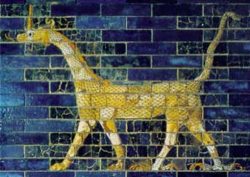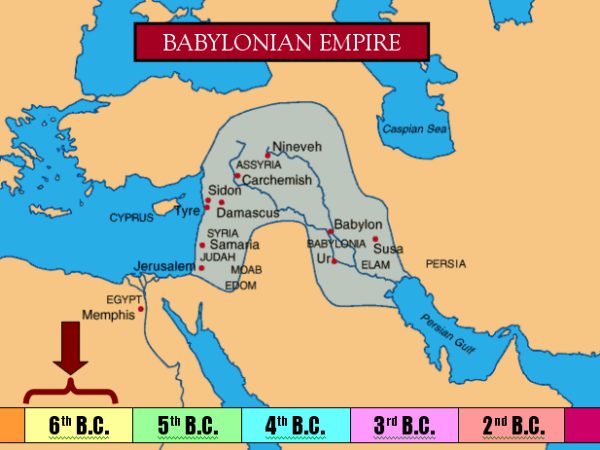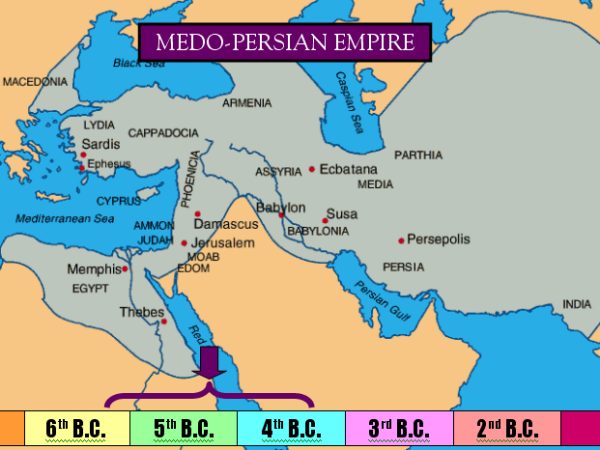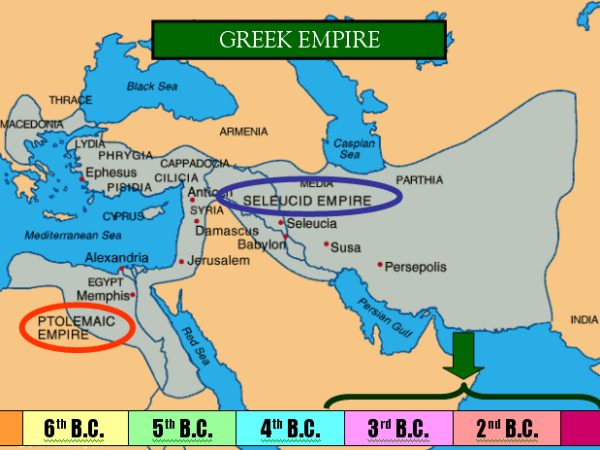Daniel is an exile. He and his companions are taken from their home in Jerusalem and hauled away to a strange and alien land. They live among people who follow different customs and religions. As people who resisted graven images they would
 have been stunned by the prevalence of bizarre sculptures and strange animals depicted everywhere. For them Babylon was a strange world.
have been stunned by the prevalence of bizarre sculptures and strange animals depicted everywhere. For them Babylon was a strange world.
Daniels experience in a strange world with different ways is not unlike our experience with the strange world of apocalyptic literature. We are familiar with the straightforward stories, but the odd material in chapters 7 through 12 can become confusing and daunting. However, if we understand the rules and expectations of apocalyptic literature, and also gain some familiarity with the concerns of the 6th and 2nd centuries B.C., then maybe we will feel more welcome in Daniels world.
Where In The World Is Daniel?
Geographically, Daniel takes place in the Middle East in the area which now contains Iran and Iraq. Daniels story and his visions involve a scope of four centuries. In that time, this region changes politically more than once. Political change in the ancient world is fluid and sudden. The fate of millions and many nations may change because of a single lost battle or the death of a monarch with an unworthy heir.
Before the Babylonian Empire, the Assyrians were the super-power in this region. The Babylonians conquered Judah, which was untouched by the Assyrian Empire. Their rule over Jerusalem and Judah began approximately with the start of the sixth century and ended in 539 B.C.

In 539 B.C., Cyrus marched on Babylonia and took the country without a struggle. Babylon opened its gates to the Persians. The Persians left the native religious institutions intact and appointed a governor to rule the territory of the Babylonian Empire. The Persians were also accepting of the Jews asserting their own religious institutions and returning to Judah and Jerusalem.

In 331 B.C., the Persian king, Darius III, faced Alexander the Great at the Battle of Gaugamela. Darius III escaped the battle but the Persian forces were defeated. Darius III was assassinated by his own people and the Persian Empire was absorbed into Alexanders empire.
Alexander ruled the area of the Persian Empire, including Jerusalem and Judah, from 332 until his death in Babylon in 323. After Alexanders death, the empire was divided up among Alexanders generals after the wars of succession. Two of those generals, Ptolemy and Seleucus, would rise to prominence and establish the two largest powers within the Macedonian empire the Ptolemaic dynasty centered in Egypt and the Seleucid dynasty centered in Syria and Babylonia.

In addition to surveying the geographical and political terrain, lets also survey the literary terrain.
|
Stories collected into two triads |
Apocalyptic visions |
|
|
|
|
The faithful are threatened by outsiders
Their faithfulness is tested by |
Dreams and signs are interpreted
The interpretation shows Gods |
Part 2 Apocalyptic Visions
- Apocalyptic literature is the account of a selected visionary who is given a view of history on cosmic scale, or from heavens perspective
- Apocalyptic literature uses symbolism: animals, numbers, and colors do not function with strict literal meaning. They engage mystical and metaphorical meanings.
- Apocalyptic literature reveals Gods involvement in history. Suffering and persecution are re-interpreted in light of what is taking place unseen in heaven.
- Apocalyptic literature gives hope to the faithful by promising that God will intervene at a designated time.
- Apocalyptic literature is a revelation of heavenly secrets; as such it always has an air of mystery.
http://www.mapsofwar.com/ind/imperial-history.html
See the 5,000 year history of the Middle East unfold in 90 seconds.
Thom Lemmons, Daniel: The Man Who Saw Tomorrow. Multnomah Press, 1991.
Donald E. Gowan, Daniel: Abingdon Old Testament Commentary. Nashville: Abingdon Press, 2001.
Significant Events
| 608597 | End of Kingdom of Judah [Removal of nobility] | |
| 597 | First deportation from Jerusalem | 2 Kings 24:10-17 |
| 587 |
Second deportation and destruction of temple and Jerusalem |
2 Kings 25:1-21; Jer. 39:1-10; Jer. 52:4-27 |
| 539 | Persian Empire conquers Babylonian Empire | Dan. 5:30 |
| 538-537 | Return to Jerusalem | Ezra 1:1-4 |
| 516 | Rebuilding of Temple | Ezra 6:1-18 |
| 459 | Ezra leads second return to Jerusalem | |
| 445 | Nehemiah rebuilds city of Jerusalem | |
| 332 | Alexander conquers Palestine | |
| 331 | Alexander defeats Darius III | |
| 323 | Alexander dies in Babylon | |
| 313 | Ptolemy I controls Jerusalem | |
| 312 | Seleucid Empire established in Babylon | |
| 301 |
Macedonian Empire divided four ways, Jerusalem and Palestine controlled by Ptolemaic Empire of Egypt | Dan. 8:8-22, 11:4 |
| 252 |
Antiochus II Theos marries Berenice, daughter of Ptolemy II | Dan. 11:6 |
| 198 |
Antiochus III wins Jerusalem from Ptolemaic control; Seleucid rule of Palestine and Jerusalem begins | |
| 193 |
Ptolemy V marries Cleopatra I Syra, daughter of Antiochus III | Dan. 11:17 |
| 170-168 |
Antiochus IV Epiphanes initiates two wars with Egypt |
Dan. 11:25-38; 7:21-25; 8:24-25; 12:7-11 |
| 167 |
Antiochus IV Epiphanes desecrates temple in Jerusalem; bans Jewish religion | 2 Maccabees 6:3-6 |
| 166162 | Maccabean Revolt | |
| 163 | Death of Antiochus IV Epiphanes |
| 605562 | Nebuchadnezzar | Dan. 1 2; 5:24-28 |
| 562560 | Amel-Marduk | |
| 560556 | Neriglissar | |
| 556 | Labashi-Marduk | |
| 556539 | Nabonidus | |
| 549539 | Belshazzar[Co-regent in Babylon] | Dan. 5:1-28, 7:1, 8:1 |
| 539 | Babylon conquered by Cyrus of Persia | Dan. 5:30 |
| 550530 | Cyrus | Dan. 6:28; 10:1 |
| 530522 | Cambyses | |
| 522486 | Darius I (Darius the Mede?) | Dan. 5:31; 6:1; 9:1; 11:1 |
| 486465 | Xerxes I (Esthers King Ahasuerus?) | Dan. 9:1 |
| 465424 | Artaxerxes I | |
| 423 | Xerxes II | |
| 423404 | Darius II | |
| 404358 | Artaxerxes II | |
| 358338 | Artaxerxes III | |
| 338336 | Arses | |
| 336331 | Darius III [Codomannus] |
| 336323 | Alexander the Great | Dan. 7:7, 8:5-8, 10:20, 11:3 |
| 323 | Wars of Sucession begin |
| PTOLEMAIC RULERS | SELEUCID RULERS | reference | ||
| Egypt (Ptolemaic) | Syria (Seleucid) | |||
| 323285 | Ptolemy I | 312280 | Seleucus I | Dan. 11:5 |
| 285246 | Ptolemy II | 280261 | Antiochus I Soter | |
| 246221 | Ptolemy III | 261246 | Antiochus II Theos | |
| 221203 | Ptolemy IV | 246226 | Seleucus II | Dan. 11:7-9 |
| 203181 | Ptolemy V | 226223 | Seleucus III | Dan. 11:10 |
| 181146 | Ptolemy VI | 223187 | Antiochus III the Great | Dan. 11:11-19 |
| Ptolemy VII [co-regent] | 187175 | Seleucus IV | Dan. 11:20 | |
| 175-163 | Antiochus IV Epiphanes | Dan. 7:8, 11, 20-22, 24-25; 8:9-11, 23-25; 9:26-27, 11:21-39 | ||
 Link to next sermon
Link to next sermon
 Link to other sermons of Chris Benjamin
Link to other sermons of Chris Benjamin